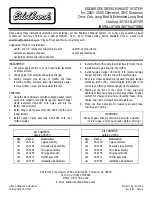
4. The resulting figure equals the available amount of
cargo and luggage load capacity. For example, if “XXX”
amount equals 1,400 lbs (635 kg) and there will be five
150 lb (68 kg) passengers in your vehicle, the amount of
available cargo and luggage load capacity is 650 lbs
(295 kg) (since 5 x 150 = 750, and 1400 – 750 = 650 lbs
[295 kg]).
5. Determine the combined weight of luggage and cargo
being loaded on the vehicle. That weight may not safely
exceed the available cargo and luggage load capacity
calculated in Step 4.
6. If your vehicle will be towing a trailer, load from your
trailer will be transferred to your vehicle. Consult this
manual to determine how this reduces the available
cargo and luggage load capacity of your vehicle.
NOTE:
•
The following table shows examples on how to calcu-
late total load, cargo/luggage, and towing capacities
of your vehicle with varying seating configurations
and number and size of occupants. This table is for
illustration purposes only and may not be accurate for
the seating and load carry capacity of your vehicle.
•
For the following example, the combined weight of
occupants and cargo should never exceed 865 lbs
(392 kg).
284
STARTING AND OPERATING
Summary of Contents for Dakota 2011
Page 1: ...Dakota O W N E R S M A N U A L 2 0 1 1 ...
Page 4: ......
Page 7: ...1 INTRODUCTION 5 ...
Page 10: ......
Page 84: ......
Page 118: ...116 UNDERSTANDING THE FEATURES OF YOUR VEHICLE ...
Page 119: ...3 UNDERSTANDING THE FEATURES OF YOUR VEHICLE 117 ...
Page 120: ...118 UNDERSTANDING THE FEATURES OF YOUR VEHICLE ...
Page 178: ......
Page 182: ...INSTRUMENT CLUSTER 180 UNDERSTANDING YOUR INSTRUMENT PANEL ...
Page 248: ...Operation Tips Chart 246 UNDERSTANDING YOUR INSTRUMENT PANEL ...
Page 287: ...5 STARTING AND OPERATING 285 ...
Page 360: ......
Page 439: ...INDEX 10 ...
Page 458: ...Chrysler Group LLC 11ND33 126 AD Fourth Edition Printed in U S A ...
















































